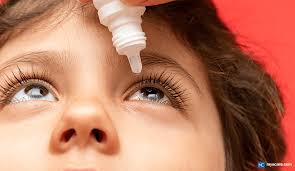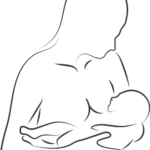Images credit to Healthshots
How To Treat Pink Eye in Babies If your little one’s eyelid is red and swollen, with some yellow crust in the corner, he may have pink eye. Pink eye, otherwise known as conjunctivitis, is the inflammation of that part of the eye called the conjunctiva, which is the membrane lining the inside of the eyelid and the eyeball.
It gets its name “pink eye” because of the color of redness or pinkish hue that the eyelid and eyeball take from inflammation and irritation. Viruses, bacteria, chemicals, allergies, or other irritants most often cause inflammation of the conjunctiva. A blocked tear duct may also be responsible for conjunctivitis in infants.
\Pink eye in babies is relatively common and usually easily treatable. Let’s discuss what to do if you think your baby has a touch of pink eye.
Causes of Pink Eye in Babies
Babies can have a pink eye which falls into two categories:
1. Pink eye that happens within the first few weeks of life.
2. Pink eye that happens later in a baby’s life.
When a baby does develop pink eye within the first weeks of life, this is often due to something that happened during the birth process—either the chemicals used to treat the eyes at birth or an infection passed along from the mother or father during vaginal delivery. Is pink eye ever serious?
Though pink eye at that stage is not serious all the time, it needs a prompt medical evaluation since it can be a symptom of a serious infection. If not treated, pink eye in newborns caused by a bacterial infection may cause serious infections somewhere else in their body or blindness and other problems with their vision.
Pink eye in newborns
If your newborn develops a case of pink eye, it usually happens within the first few weeks following birth. Here’s what to know if you’re dealing with pink eye in newborns.
Blocked tear duct. This occurs because your baby’s tears can’t drain and most often resolve as your baby matures. It is relatively common and harmless, but always should be evaluated by your healthcare provider to make sure it is nothing more serious.
Topical antimicrobial. Eye drops given to your baby at birth to prevent bacterial infections may cause a condition called “chemical conjunctivitis,” whereby the eye gets irritated. Such irritations generally clear up easily and are not considered medical emergencies.
Bacterial infections at birth: The infection may be passed to the newborn by the parent at birth. These infections don’t affect only the eye, and, as stated above, they can be very serious in case of non-prompt treatment.
Other viral or bacterial infections. Besides bacterial infections at birth, your baby can pick up a bacterial or viral infection that affects their eye and leads to pink eye symptoms. These infections also can lead to other symptoms in the body—most frequently respiratory symptoms or fever. Any bacterial or virus infection in a newborn should be treated seriously and requires prompt medical evaluation.
Pink eye in older babies
Older babies may also have a pink eye for the same reasons that newborns do, including:
Pink eye from bacterial infections—although these won’t be the birth-acquired bacteria
Older babies will have pink eye related to common viral infections—and, often, you may notice their eyes become irritated when they have colds and other respiratory infections
Older babies may also develop pink eye as a manifestation of allergies
Although less common than in the newborn stage, pink eye can also occur in older babies due to blocked tear ducts
Symptoms of Pink Eye
Symptoms of pink eye are pretty obvious, you will notice your baby’s eyelid is pink and puffy looking, there could be a crusty buildup in corners of their eyes and their eyeball itself may have that pinkish hue.
Depending on the cause, pink eye presents slightly differently. Most importantly, if pink eye is accompanied by other concerning symptoms of illness, this could signal a more serious issue.
Also Read : Your Guide to Freezing Baby Food
Blocked tear ducts
Symptoms include watering of the eye, redness or swelling of the eye, and crusty discharge in the corner of the eye. Most babies grow out of blocked tear ducts by the first few months of life, but in some babies, these symptoms can last the entire first year of life. Discuss your baby’s blocked tear duct with your healthcare provider if it has not gone away by their first birthday.
Topic antibacterial
If the eye drops your newborn received at birth caused their pink eye, they may have a slightly red eye with some mild swelling of the eyelid. The pink eye caused by the antimicrobials normally resolves on its own and without treatment in 24 to 36 hours.
Bacterial infections Acquired at birth
Symptoms of bacterial infection from bacteria like chlamydia, gonorrhea, and less often, herpes include swelling of the eyelid, purulent discharge, and red eye. Chlamydia infection symptoms manifest five to 12 days after birth while Gonorrhea infection symptoms are manifested about two to five days after birth.
These infections can develop to include severe symptoms in other parts of a neonate’s body if not treated. Chlamydia can lead to infection of the lungs and nasopharynx. Gonorrhea can lead to infection of the bloodstream, spinal cord, and lining of the brain. Herpes infection leads to loss of vision or blindness if it is not treated.
Other bacterial infections
Bacterial causes of pink eye include swelling of the eyelid and pinkness of the eyelid and eyeball. This type of infection is often associated with discharge from the eye. The discharge can cause the eyelids to stick together. A coincidence of bacterial pink eye infections is often an ear infection.
Viral infections
How To Treat Pink Eye in Babies
Viral pink eye occurs most commonly with respiratory infections like colds or flu. More prominent symptoms include redness of the eyelid and the eyeball, which appears pink in color; however, this infection does not have any thick discharge like an infection from bacteria. You might have a watery-like discharge, and it starts in one eye before spreading to the second.
Allergies
Pink eye due to allergy generally occurs with other allergy symptoms like sneezing, itchiness, tearing, scratchy throat, coughing, or asthma symptoms. The pink eye from an allergy will usually affect both eyes.
How To Treat Pink Eye in Babies
How To Treat Pink Eye in Babies
Report any pink eye in a newborn to a healthcare provider immediately. Treat any suspected bacterial or viral infection in a newborn as more severe than in an older baby, as newborns are at higher risks of serious symptoms and outcomes.
If your older baby has a puffy, swollen, or reddening eyelid or eyeball, you should call your healthcare provider to discuss whether your baby needs to be seen. Often, if there are no other serious symptoms, the pink eye isn’t very bothersome to your baby, and you can wait until the next available appointment for your visit.
If your healthcare provider thinks you may need urgent treatment, they may request to see you immediately, or they may send you to an urgent care center.
How To Treat Pink Eye in Babies diagnosed?
How To Treat Pink Eye in Babies to see their health care provider, the baby will be examined well and the health professional will ask you questions about when the pink eye symptoms started, if your baby has other symptoms, and may question you about his/her overall medical history.
Sometimes, your healthcare provider may collect a sample of your baby’s eye drainage to send to a laboratory. This will help show if there is a bacterial infection, and if so, what the infection could be. In that case, antibiotic medicine can be prescribed to specifically fight that particular bacteria. This won’t hurt your baby, but it might be uncomfortable.
Names of Medications
Which of the following medications are used to treat pink eye?
Treatment can begin after you receive a proper diagnosis of your baby’s pink eye. One needs to get a diagnosis from the doctor because there are many different causes of pink eye, and the kind of treatment depends on the cause.
Learn how to treat the different causes that lead to pink eye in this section.
Bacterial: Your healthcare provider will prescribe antibiotic drops or ointments, depending on the type of bacteria involved in the infection. Newborns with bacterial infections like chlamydia and gonorrhea need to receive oral or IV antibiotics if they contract them at birth.
Viral: There is no medication to treat pink eye caused by a virus. But, sometimes a secondary bacterial infection does occur and the doctor may prescribe antibiotic drops. At this point, consider using warm compresses. Practice good hand hygiene to prevent the spread of viral infections in the eye.
Allergic: For allergic pink eye, your doctor may prescribe antihistamine medication or drops. You should talk to your healthcare provider about using allergy medication with an infant. Most allergy medications are not safe for babies under age 2.
Blocked tear duct: Warm compresses can soothe blocked tear ducts when applied a few times a day. Your healthcare provider may also want you to massage the duct. This is something you should only do if guided to do so by your pediatrician.
Can pink eye be prevented?
To prevent bacterial infections caused at birth, ensure that you undergo testing and treatment for common bacterial infections such as chlamydia, gonorrhea, and herpes. Now, the antibiotic drops that babies get at birth also go a long way in prevention.
Note that infections can spread from eye to eye, or from your eye to your baby’s eye. If your baby is receiving treatment for an infection, his/her eye might stay infectious 24 to 48 hours after starting treatment and during this time period may continue to pass from one eye to the other.










